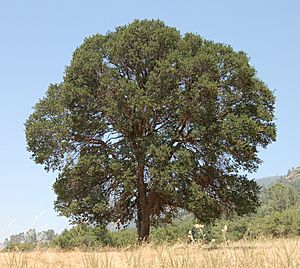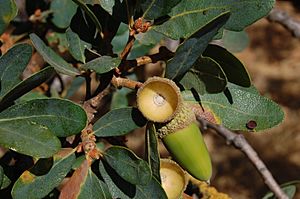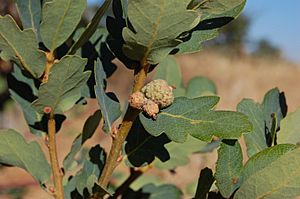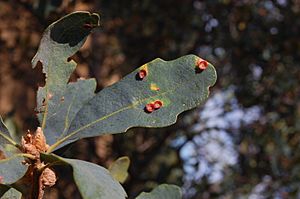Blue oak facts for kids
Quick facts for kids Blue oak |
|
|---|---|
 |
|
| A large blue oak in a pasture in Mariposa County, California | |
| Conservation status | |
| Scientific classification | |
| Genus: |
Quercus
|
| Species: |
douglasii
|
 |
|
| Natural range | |
| Synonyms | |
|
|
The blue oak (scientific name: Quercus douglasii) is a special type of oak tree. It is endemic, meaning it is found only in California. You can often see it in the Coast Ranges and the foothills of the Sierra Nevada.
This tree is California's best at handling dry weather among its deciduous (leaf-shedding) oak relatives. It is a very important tree in the blue oak woodland areas. Sometimes, people also call it the mountain oak or iron oak.
Contents
What's in a Name?
The blue oak, Quercus douglasii, is named after a Scottish plant expert named David Douglas. He discovered many plants.
The common name "blue oak" comes from the slightly blue-green color of its leaves. It belongs to a group of oaks called the "white oaks."
About the Blue Oak Tree
The blue oak is a medium-sized tree that doesn't have a lot of leaves. It usually grows to be about 6 to 20 meters (20 to 66 feet) tall. Its trunk is typically 36 to 60 centimeters (14 to 24 inches) wide. Most blue oaks have one main trunk, but some have several. The tallest one ever found was 28.7 meters (94 feet) tall in Alameda County.
These trees grow slowly, about 30 centimeters (12 inches) each year. Some blue oaks have lived for more than 500 years!
The bark of the blue oak is light gray. It has many dark cracks. The blue-green leaves are tough and feel like leather. They fall off the tree each year. These leaves are 4 to 10 centimeters (1.6 to 3.9 inches) long. They can be smooth on the edges or have shallow lobes (rounded parts).
The acorns are 2 to 3 centimeters (0.8 to 1.2 inches) long. They have a somewhat sweet inside part, called a kernel. Acorns take about 6 to 7 months to grow after the tree is pollinated.
Blue oaks are monoecious, which means each tree has both male and female flowers. The wind carries the pollen from one flower to another. The tree's pollen can cause allergies for some people.
Where Blue Oaks Grow
Blue oaks like dry to slightly moist soil and lots of sunshine. Because their leaves are not very dense, more sunlight can reach the ground below them. Young blue oak trees can grow for many years under their parents' canopies.
These trees often grow next to gray pine trees. You can also find them with other oaks like interior live oak, coast live oak, valley oak, Oregon white oak, and canyon live oak. Sometimes, blue oaks naturally mix with other oak types. This happens when their pollen mixes, creating new hybrid trees.
Old blue oak forests are some of the oldest and most common natural areas left in California.
Handling Dry Weather
The blue oak is the best at handling dry weather among California's oaks that lose their leaves. It has a smaller leafy top than other oaks. It also grows more roots than leaves throughout its life. The tough, blue-green leaves help it survive dry times. During droughts, their blue color becomes even stronger.
In very dry years, blue oaks might drop their leaves in summer instead of fall. But they usually still grow their acorns through the fall. If it's too dry, the trees might not even flower in the spring.
Gall Wasps
More than 50 different kinds of gall wasps live on blue oak trees. These tiny wasps cause the tree to grow strange bumps called oak galls. These galls come in many different shapes, colors, and sizes.
Resistant to Sudden Oak Death
There is a serious tree disease called sudden oak death. It is caused by a tiny organism called Phytophthora ramorum. As of 2002, this disease had not been found in blue oaks or other white oaks. Experiments have shown that blue oaks seem to be naturally resistant to this disease.
How People Use Blue Oaks
Long ago, Native Californians often collected blue oak acorns. They thought the acorns tasted good. They would grind them into acorn flour. They also used blue oak seedlings to make baskets. From the wood, they made tools like bowls. They even made dye from the acorns.
Today, blue oak wood is mainly used for firewood. Wildlife and farm animals also eat the acorns. People can eat the acorns too, but if they taste bitter, they might need to be washed to remove the bitter taste.
See also
 In Spanish: Roble azul para niños
In Spanish: Roble azul para niños





